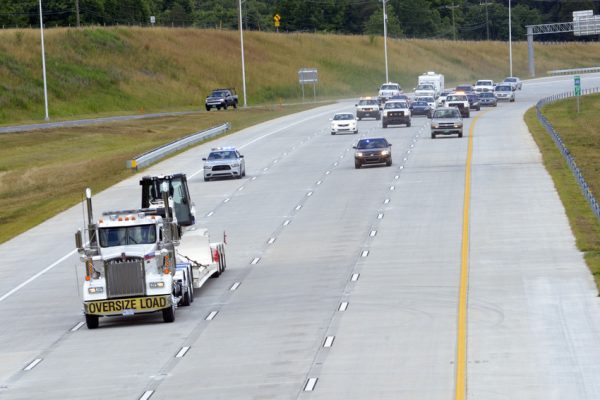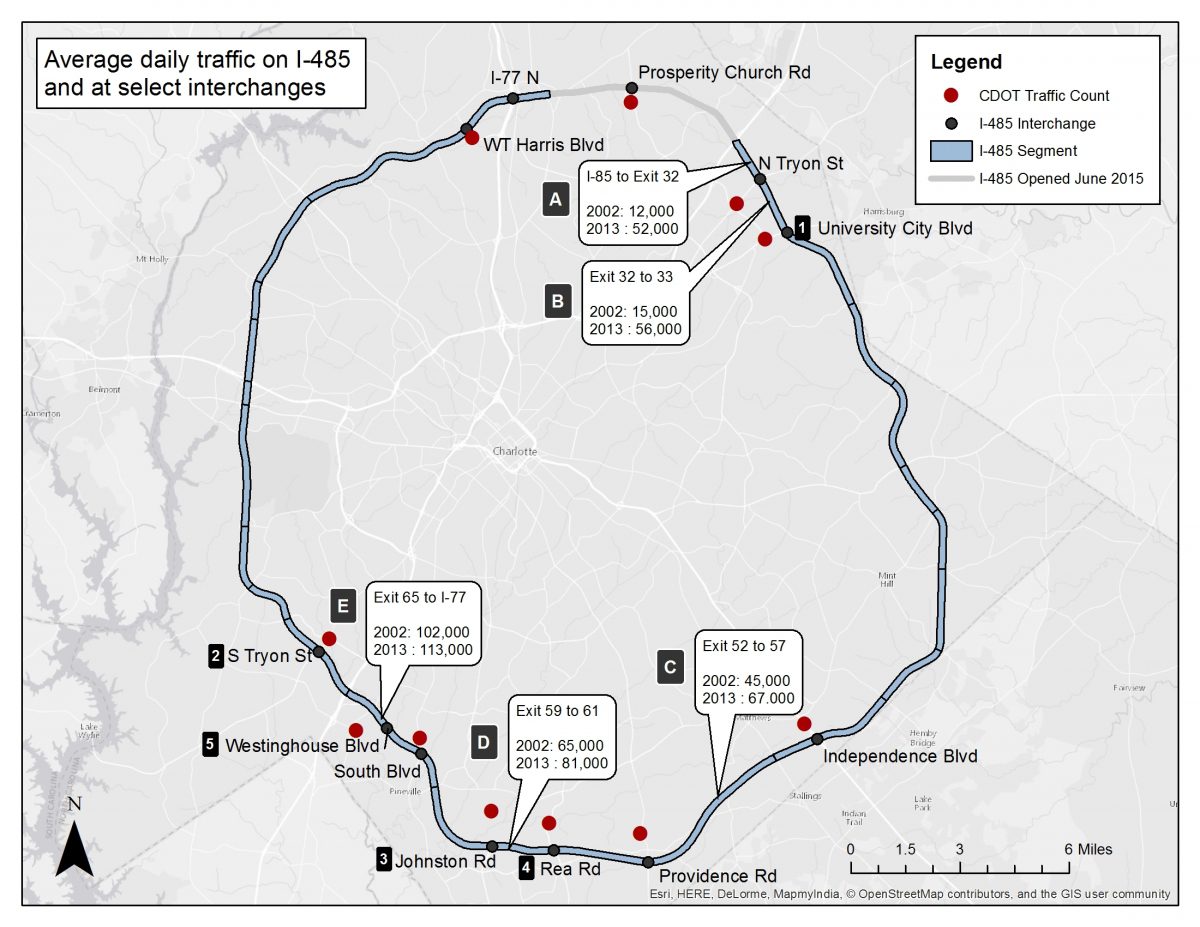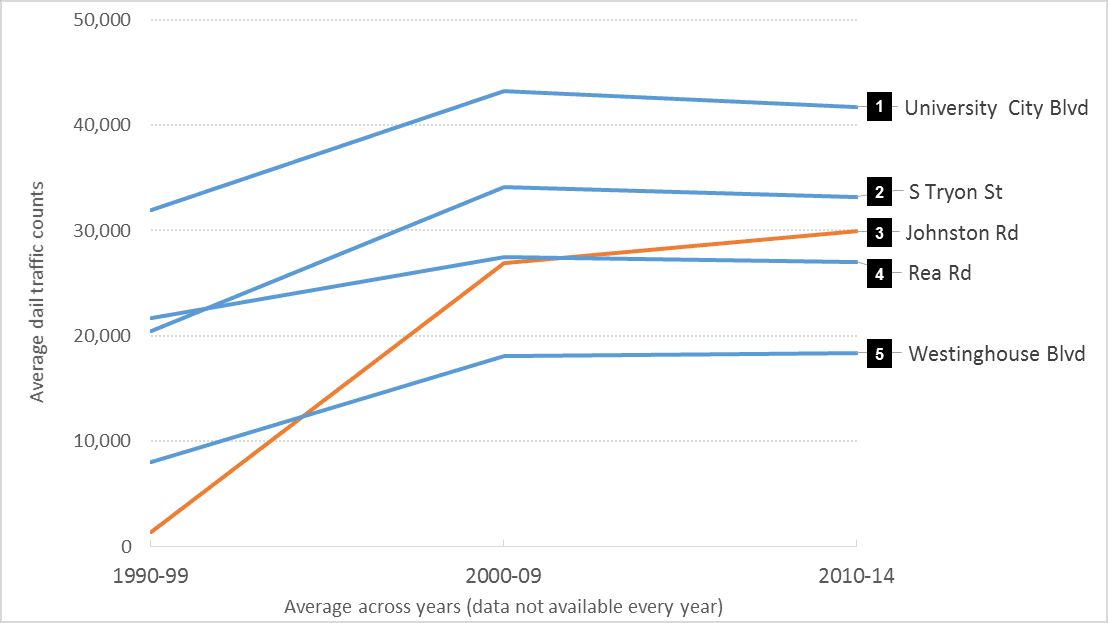Charlotte’s I-485 lures growth, and with growth comes traffic

With the final leg of I-485 opening in June, motorists cheered the new, unclogged lanes. But if the past is prologue, eventually new development nearby will bring congestion.
Across the United States, it’s always the same story with the same ending: a loop highway is built around a growing city. It provides traffic relief for a while and then becomes congested. Eventually, it is widened or other traffic measures are put into place.
In the Charlotte area, that tale is just beginning. The June 5 opening of the northeast segment of Interstate 485, the final leg of the 67.6-mile outerbelt that’s been under construction for 27 years, will ease congestion on heavily traveled roads in the growing University City area and provide better access to and from the northern areas of Mecklenburg County. The entire loop now provides a faster travel option around Charlotte for motorists who want to avoid the stop-and-go of city streets.
I-485, the road that shape-shifted Charlotte growth
Some I-485 interchanges see growth zoom, others languish – for now
But on the rapidly growing southern side of Charlotte and Mecklenburg County, the first segment of the highway to open in the 1990s already has exceeded its initial capacity as a four-lane road. The state recently finished an $83.3 million widening to six lanes, and more improvements are coming.
The completion of the $1.325 billion highway marks Charlotte’s entry into a relatively small group of cities and metropolitan areas facing the double-edged sword of major highway construction: It helps, and it hurts. It eases congestion, and sparks more development, which leads to more congestion. The growth is, of course, an indication of a healthy local economy, but with it comes the challenge of how to manage it.
“We’re trying to find ways to avoid congestion,” says Warren Cooksey, a former Charlotte City Council member now director of outreach and community affairs for the local division of the North Carolina Department of Transportation. “This area is not finished growing.”
Traffic growth around I-485

Traffic increases 2002-2013 for selected I-485 segments (click here for full chart)

Traffic increases 1990s-2000s on roads near I-485 interchanges (click here for full chart)

Data sources: N.C. Department of Transportation, Charlotte Department of Transportation. Map: Katie Zager
Population boomed
Mecklenburg County’s population has jumped to more than 1 million, and much of the metro region is robustly emerging from the economic slowdown of the Great Recession that hit in 2007-09. But back in 1980, when the outerbelt was still in the planning stage, the county population was just 404,270.
In that era, the highway was viewed as more than just a way to improve mobility, long-time area transportation planner Bill Coxe remembers. Coxe works in Huntersville but spent 20 years as Mecklenburg transportation planner, starting in the mid-1970s. He believes the road’s early backers saw it also as an economic development venture. “The people who were pushing it,” he recalls, “were pushing it as an economic recruiting tool for the region at large. That was in the era of ‘seeking to be world-class.’ ”
In recent decades the population growth in Mecklenburg and neighboring counties has made the whole region one of the fastest growing in the country. To the south, Union County grew from 70,380 in 1980 to 214,568 in 2014—a 204 percent increase. During those years Cabarrus County’s population increased 124 percent, from 85,895 to 192,103. The 10-county metro region today has a population of 2.5 million, and a United Nations projection concluded that by 2030 Charlotte would be tied with Raleigh as the county’s fastest-growing city areas.

Traffic congestion and capacity
The outerbelt curves from four to eight lanes around Charlotte, with 34 interchanges. It has a scenic quality. There are no billboards. Much of the roadside property remains undeveloped. Fewer than a dozen interchanges so far have attracted heavy development, although developer interest is percolating in some areas as the economy continues to strengthen.
While the population growth rate for the whole county between 1980 and 2010 was roughly 100 percent, the growth rate around some interchanges was more than 10 times that. At the Prosperity Church Road interchange in northeast Charlotte, people moved in before the road was built. That highway segment opened just a month ago. But from 1980 to 2010, the population roughly a mile from that interchange grew by nearly 1,500 percent. On the southern side of the city, the population a mile or so around the Johnston Road interchange, gateway to the popular Ballantyne development, grew 755 percent. The area around the Rea Road interchange grew 1,100 percent.
And along with more people come houses, stores and office buildings—and cars. Average daily traffic counts from the N.C. Department of Transportation for different segments of I-485 illustrate the rise in congestion from 2002 to 2013, the earliest and latest years those counts were available. For example:
- From Interstate 85 to North Tryon Street (Exit 32): From 12,000 in 2002 to 52,000 in 2013.
- From North Tryon Street (Exit 32) to University City Boulevard (Exit 33): From 15,000 to 56,000.
- From Rea Road (Exit 59) to Johnston Road (Exit 61): From 65,000 to 81,000.
- From South Boulevard (Exit 65) to Interstate 77 (Exit 67): From 102,000 to 113,000.
See table of traffic counts 2002-2013 along sections of I-485
Traffic has also grown on thoroughfares near the outerbelt interchanges. The Charlotte Department of Transportation counts average daily traffic at various spots around the city. The counts aren’t done yearly at each spot, but the pattern is clear. For instance, traffic on Providence Road between Raintree Lane and Alexa Road in 1984 was 8,300. Outerbelt construction began in 1988. By 2013 traffic was 30,600.
Other interchange areas show similar increases. For example:
- Johnston Road, between Hildreth Court and Carmel Road, had an average daily traffic in 1985 of 1,200. By 2008 the traffic count peaked at 32,500. Since then it has dipped, and in 2013 was 26,800.
- North Tryon Street north of Mallard Creek Church Road, near the fast-growing UNC Charlotte campus, saw 9,200 vehicles a day in 1982. By 2013 it saw 33,500.
See table of traffic counts at 11 interchange areas during 1980s, 1990s, 2000s and 2010s.
To help move traffic faster and with greater ease, the outerbelt features some of the latest innovations in highway construction. Three of the new interchange designs are the first of their kind in the state, including a large interchange at Interstate 85 known as a turbine, because it channels all left-turning traffic in a circle around a central bridge in a counterclockwise direction.

Transportation officials also describe completion of I-485 as the end of an era, of sorts. Due to increasing construction costs and a tight state budget, some future roadways are likely to include toll express lanes, including new lanes on the southern leg of the outerbelt. Eventually, if motorists want to bypass the worst congestion on highways, they will have to pay to do so.
“The final segment represents a victory in doing more with less,” says Jordan-Ashley Baker, communications officer with the local division of the N.C. Department of Transportation. “We have to do more with less these days.”
Because the southern leg of the road has grown so congested, state officials plan to add toll express lanes between I-77 and U.S. 74 beginning in 2019. Other planned construction projects include an interchange at Oakdale Road in the northwest, scheduled to begin this August. An interchange at Weddington Road in Matthews will get underway in the next few years, according to state transportation officials.
Did transit plans keep center of city healthier?
In the late 1990s, as Charlotte-Mecklenburg planners were pushing the community to consider options for managing the growth the outerbelt would generate, work was also underway on transit planning, in hopes of encouraging development along transit lines.
Charlotte’s land use plan was to try to counterbalance the development pull generated by I-485 by concentrating growth in the major centers such as SouthPark and along transportation corridors, rather than end up with a doughnut of disinvestment between the center city and the outerbelt. Officials adopted a long-range transit/land use plan in 1998, focusing on growth along five major transportation corridors, and that year Mecklenburg voters approved a half-cent sales tax to pay for the transit system. Today the transit plan encourages higher density development in some areas.
“To me, that was a good plan,” says Ron Tober, the first CEO of the Charlotte Area Transit System, from 1999-2007. Did it work? “The jury’s still out on that.”
Tober points to evidence that investing in infrastructure inside the outerbelt, including light rail, was effective—millions of dollars in real estate investment along the Lynx Blue Line light rail and in the SouthPark area.
Former Charlotte Mayor Harvey Gantt applauds the city’s efforts to plan for light rail and the success in winning federal money for the growing system. “I still hope we become more aggressive and seek more dollars,” he says.
“What I think is dominant is that people still feel that the mode of transportation is the automobile, and that we still need to accommodate it by building highways.”